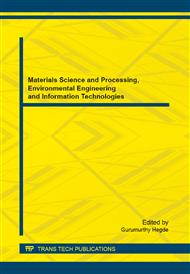[1]
X. Li, M. X. Wan, Y. Wei, et al. Electro-magnetic functionalized and core-shell micro/nanostructured polypyrrole composites. The Journal of Physical Chemistry B. 110(2006) 14623-14626.
DOI: 10.1021/jp062339z
Google Scholar
[2]
Turkarslan O, AkM, Tankeli C, et al. Enhancing electrochromic properties of conducting polymers via copolymerization: copolymer of 1-(4-fluorophenyl)-2, 5- di(thiophen-2-yi)-1H-pyrrole with 3, 4-ethylene dioxythiophene. J. Poly. Sci. PartA: Poly. Chem.; 45(2007).
DOI: 10.1002/pola.22166
Google Scholar
[3]
G.H. Chen, J.X. Deng. New electrochromic film material, Chemical Industry Press. Beijing, 2002, 253-260.
Google Scholar
[4]
Pierre M. Beaujuge, John R., Color control in π-conjugated organic polymers for use in electrochromic devices, Chem. Rev. 110(2010) 268-320.
DOI: 10.1021/cr900129a
Google Scholar
[5]
X. Li, G. L. Zhao, J. Qian, et al, Preparation, structure and electrochromic properties of poly(3, 4-ethylenedioxythiophene) based conducting textile, Chemical journal of Chinese universities. 30(2009) 1052-1054.
Google Scholar
[6]
G.S. Liu, C.W. Chang, H.M. Huang, et al, Synthesis and Electrochromism of Novel Organosoluble Polyarylates Bearing Triphenylamine Moieties, J. Poly. Sci. PartA: Poly. Chem. 45(2007) 2004-(2014).
DOI: 10.1002/pola.21966
Google Scholar
[7]
Ak, Cihangir Tanyeli, Idris M. Akhmedov, Levent Toppare, Enhancing electrochromic properties of conducting polymers via copolymerization: copolymer of 1-(4-fluorophenyl)-2, 5-di(thiophen-2-yl)-1 H-pyrrole with 3, 4-ethylene dioxythiophene, J. Poly. Sci. PartA: Poly. Chem. 45(2007).
DOI: 10.1002/pola.22166
Google Scholar
[8]
Emerson M. and Macro-A. De Paoli, Polypyrrole color modulation and electrochromic contrast enhancement by doping with a dye, Adv. Mater. 10(1998) 790-793.
DOI: 10.1002/(sici)1521-4095(199807)10:10<790::aid-adma790>3.0.co;2-r
Google Scholar
[9]
Yutaka Ohmori, Yashuhiro Hironaka, Masayoshi Yoshida, et al, Enhancement of electroluminescence intensity in poly(3-alkylthiophene) with different alkyl side-chain length by doping of fluorescent dye, Polymers for Advanced Technology. 8(1997).
DOI: 10.1002/(sici)1099-1581(199707)8:7<403::aid-pat663>3.0.co;2-o
Google Scholar
[10]
Jonas Friedrich, Heywang Gerhard, Schmidtberg Werner, et al, European Patent 339, 340(1989).
Google Scholar
[11]
Jonas Friedrich, Krafft Werner, European Patent 440, 957(1990).
Google Scholar
[12]
Namboothiry MAG, Zimmerman T, Coldren FM, et al, Electrochromic properties of conducting polymer metal nanoparticles composites, Synth. Met. 157(2007) 580-584.
DOI: 10.1016/j.synthmet.2007.06.006
Google Scholar
[13]
H.J. Zheng, Y.D. Jiang, J.H. Xu, et al, Performance optimization of OLED device with LB film of PEDOT/PSS, CIESC Journal. 61(2010) 1582-1586.
Google Scholar
[14]
Hoppe H, Arnold N, Sariciftci N S, et al, Modeling the optical absorption within conjugated polymer/fullerene-based bulk-heterojunction organic, Sol. Energy Mater. Sol. Cells. 80(2003)105-113.
DOI: 10.1016/s0927-0248(03)00137-5
Google Scholar
[15]
J. H. Zhang, Assembly Technology of All-solid State Electrochromic Device, Beijing Institute of Fashion Technology(2009).
Google Scholar
[16]
X. Li, J. Y. Shen, M. X. Wan, Z. J. Chen, Y. Wei, Core-shell Structured and Electro-magnetic Functionalized Polyaniline, Synthetic Metals. 157(2007) 575-579.
DOI: 10.1016/j.synthmet.2007.06.007
Google Scholar
[17]
Y. J. Yang, Y. D. Jiang J. H. Xu, et al, Preparation and Properties of Conducting Polymer Poly(3, 4-ethylenedioxythiophene) Nanoparticles, Chemical Journal of Chinese Universities. 28(2007) 1739-1742.
Google Scholar
[18]
X. Li, M. X. Wan, X. N. Li, G. L. Zhao, The Role of DNA in PANI-DNA Hybrid: Template and Dopant, Polymer. 50(2009) 4529-4534.
DOI: 10.1016/j.polymer.2009.07.024
Google Scholar
[19]
X. G. Li, H. Y. Wang, M. R. Huang, Synthesis, Film-Forming and Electronic Properties of o-Phenylenediamine Copolymers Displaying An Uncommon Tricolor, Macromolecules. 40(2007) 1489-1496.
DOI: 10.1021/ma062463g
Google Scholar


